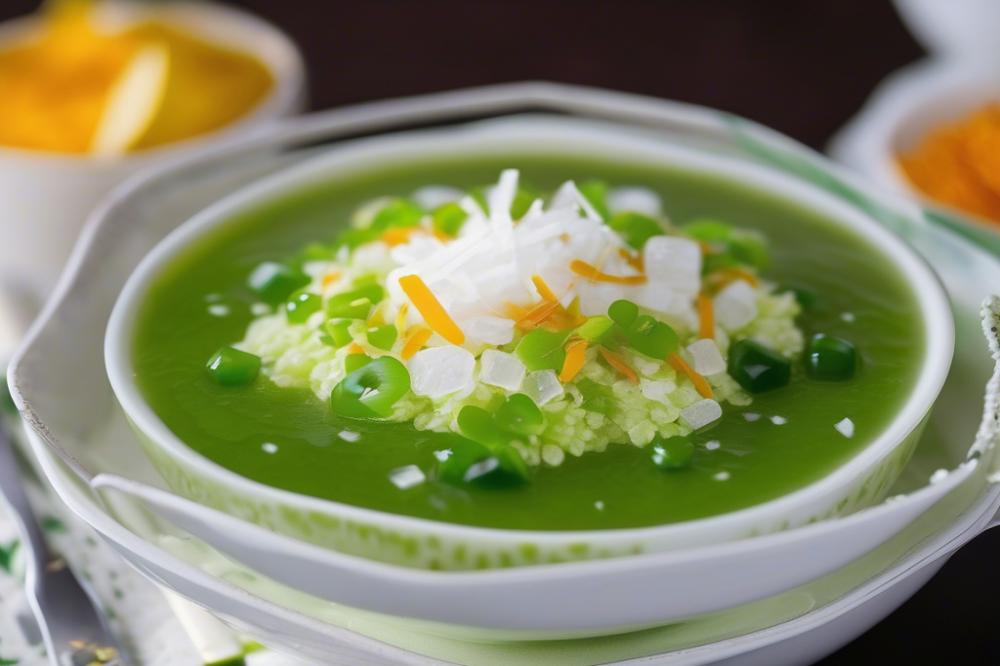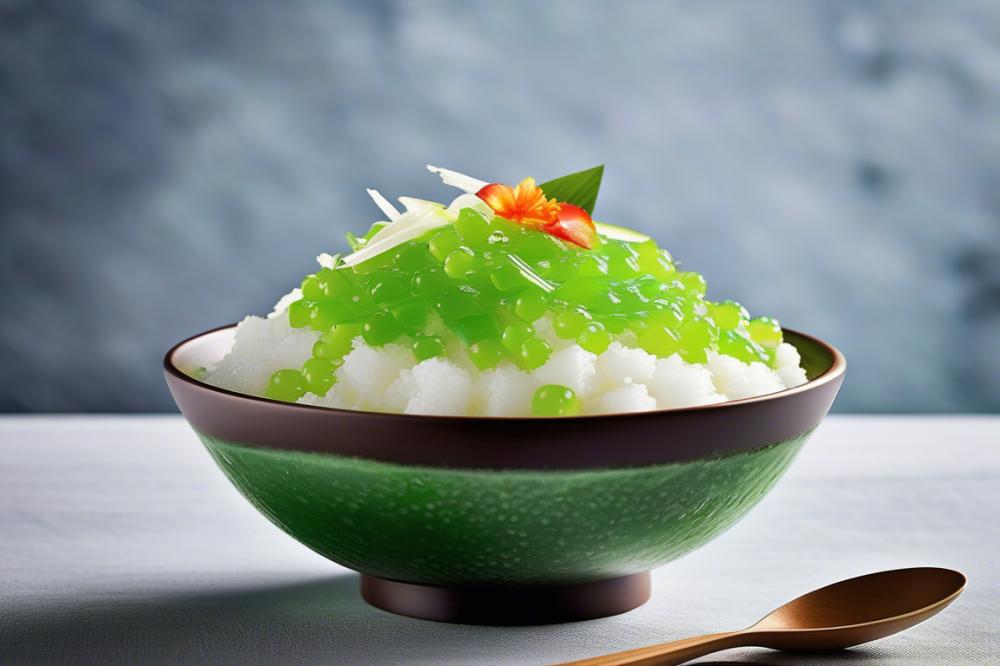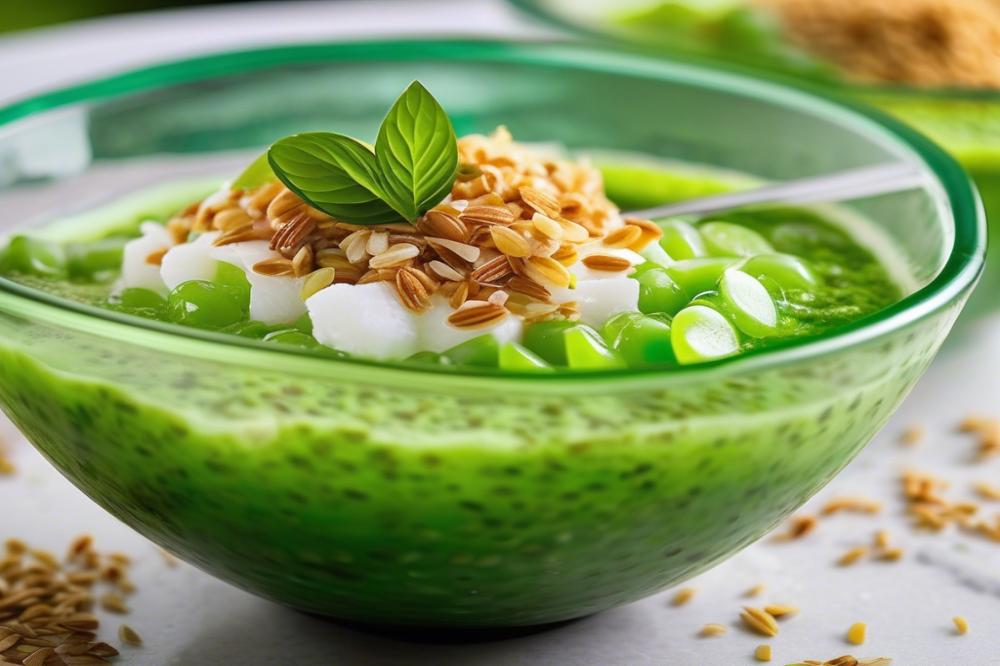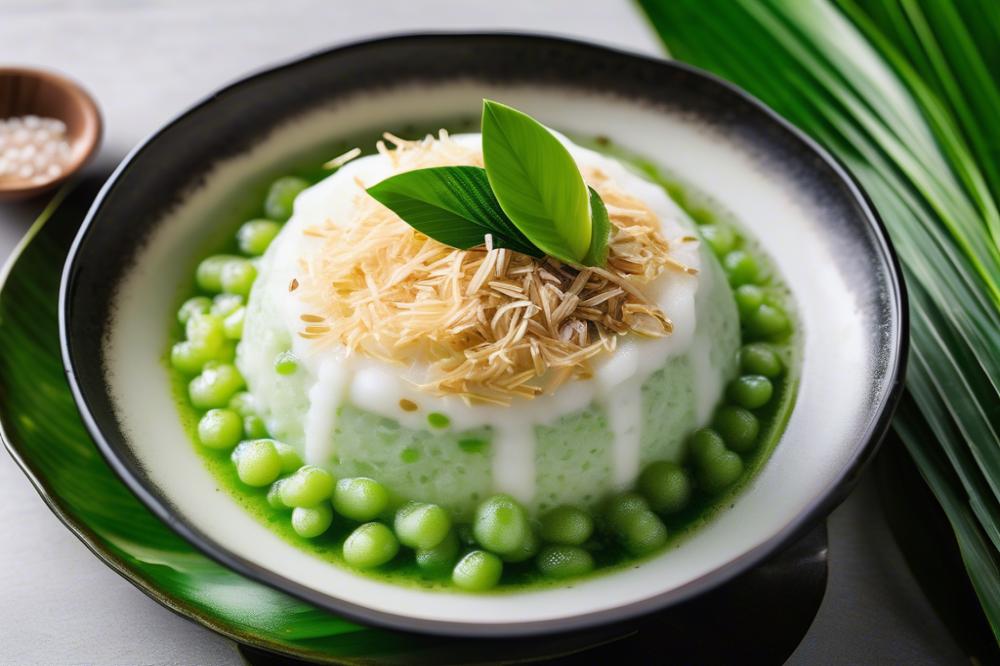Introduction
Cendol stands proudly as a classic Malaysian dessert that captures the essence of tropical flavors. This delightful treat combines various ingredients to create a delicious experience that many cherish. With its refreshing qualities, it serves as a popular way to cool down in the tropical heat of Malaysia and beyond. The smoothness of the green jelly, made from pandan leaves, contrasts beautifully with rich coconut milk. Topped with ice and drizzled generously with sweet gula Melaka, each bite brings a wave of happiness.
In Malaysian culture, this sweet dish holds significant importance. It is often enjoyed during family gatherings or festive occasions. Friends love to share it at roadside stalls, where stalls display their colorful offerings. Enthusiasts of Southeast Asian cuisine appreciate the unique combination of textures and flavors that Cendol provides. The combination of creamy and sweet elements creates a balance that makes this dessert unforgettable. A visit to Malaysia is simply incomplete without trying it!
What is Cendol?

This traditional Southeast Asian dessert has captured the hearts of many with its delightful combination of flavors and textures. Cendol is a refreshing treat, perfect for hot days or simply to enjoy as a sweet snack. It features several key ingredients that come together to create a unique experience.
At the heart of this dessert lies the vibrant green jelly made from pandan leaves. The jelly is shaped into thin ribbons, adding a playful touch to the dish. This green jelly not only provides color but also presents a chewy texture that contrasts well with other elements.
Coconut milk plays a crucial role too. Its creamy richness brings depth to the dessert. When poured over the jelly and ice, the coconut milk creates a luscious base that complements the sweetness of the gula Melaka. This palm sugar is dark brown and syrupy, giving the dessert a wonderful caramel undertone. Its distinct flavor enriches the overall taste experience.
The dessert is often served over shaved ice. This fluffy ice adds a refreshing chill that makes each spoonful enjoyable. The combination of ice, jelly, and coconut milk forms a delightful mixture. Visually, the vibrant green stands out against the white coconut milk and golden-brown gula Melaka. The colors make it very appealing.
With each bite, you encounter different sensations. The sweetness from the gula Melaka mingles with the creaminess of the coconut, resulting in a harmonious blend. Altogether, Cendol is not just a dessert; it is an experience that refreshes the palate and satisfies sweet cravings.
Ingredients and Cooking Instructions

To prepare this delightful dessert, gather the following ingredients:
- 100g rice flour
- 50g green pea flour
- 1 tsp pandan extract
- 400ml water
- 400ml coconut milk
- 150g gula Melaka (palm sugar)
- Ice (crushed or shaved)
- A pinch of salt
Now, let’s move on to the cooking instructions.
First, mix rice flour, green pea flour, pandan extract, and water in a bowl. This combination will create a smooth batter.
Next, cook the mixture in a saucepan over low heat. Keep stirring continuously until it thickens to a jelly-like consistency.
Once thickened, pour the mixture into a mold and allow it to cool. This step is essential for setting the jelly.
After it has set, cut the green jelly into strips. Make sure the strips are uniform for a pleasant presentation.
In a separate saucepan, dissolve gula Melaka in coconut milk over low heat. Stir until the sugar completely dissolves, creating a sweet and rich sauce.
For serving, place the iced jelly strips in a bowl. Pour the luscious coconut milk mixture over the top. Finally, add crushed ice to keep it refreshing.
Nutritional Information
Each ingredient contributes unique nutritional benefits. For example, rice flour is gluten-free and provides carbohydrates for energy. Green pea flour adds proteins and fiber, giving a nutritious boost. Pandan extract not only adds flavor but is believed to have health benefits, including antioxidants.
Coconut milk offers healthy fats and vitamins. It contains medium-chain triglycerides, which may support metabolic health. Gula Melaka gives a sweet richness to the dish but should be enjoyed in moderation due to its calorie count. A typical serving of this dessert provides approximately 200 calories.
Using this combination of ingredients, the dish not only satisfies your sweet cravings but also offers various vitamins and minerals. Enjoying this traditional Southeast Asian treat is a wonderful way to indulge while savoring unique flavors and textures.
Cultural Significance of Cendol

Cendol holds a special place in Malaysian culture. This dessert has a history that stretches back centuries. It is believed to have origins in Java, Indonesia, but it has truly found a home in Malaysia. Variations of the dish can be found across Southeast Asia, with each country adding its own twist. While the basic elements remain, different regions offer distinct flavors and ingredients.
This sweet treat is often enjoyed during festivals and celebrations. Street vendors serve it during special occasions and everyday moments alike. In Malaysia, it has become a popular choice on hot days. Families gather in the evenings to enjoy cendol after a long day. It brings people together, making it more than just a dessert.
Traditional ingredients play a crucial role in creating its unique flavor. The delicious green jelly made from pandan adds a fragrant aroma. This plant is a staple in many Southeast Asian dishes, valued for its vibrant color and taste. Gula Melaka, or palm sugar, brings additional sweetness. Its rich, caramel-like flavor perfectly complements the coconut milk. Together, they create an unforgettable experience for the taste buds.
Street food culture thrives on variety and freshness. Cendol stalls dot busy markets and highways, showcasing its popularity among locals and tourists. Each vendor often has their own secret recipe, making each bowl an experience of its own. This refreshing dessert is a testament to Malaysia’s diverse culinary landscape, reflecting both tradition and innovation.
Celebrations often signify more than just food; they are about heritage. Cendol, served at weddings and family gatherings, signifies joy and togetherness. Though it can be enjoyed at any time, it becomes even more special when shared with loved ones. The sweet, cold dessert has a way of evoking memories and creating new ones.
Variations of Cendol
This delightful dessert has many variations across Southeast Asia. In Indonesia, for example, cendol features a different take on flavors and textures. The green jelly is often made using fresh pandan leaves, giving it a fragrant aroma. Instead of the standard toppings, some prefer to add red beans or even sweet corn. These ingredients lend a unique twist that pleases the palate.
Thailand also offers its own interpretation of this traditional sweet treat. Thai versions might include coconut milk blended with a sweeter syrup made from coconut sugar. It’s common to see a variety of toppings, such as fresh fruits or even grass jelly, which adds to the texture and visual appeal. The vibrant colors create an enticing display that makes it hard to resist.
Modern takes on cendol do not shy away from experimentation. Chefs often incorporate unconventional flavors like matcha or chocolate, while still respecting its roots. These new ideas aim to enhance the dessert without losing the fundamental elements that define it. Whipped cream has also made a surprising entry, adding a creamier texture that contrasts well with the ice.
No matter the variation, coconut milk remains a staple. Its creamy richness enhances the overall taste, making each spoonful a pleasure. The sweetness of gula Melaka brings everything together, creating a harmonious balance. Whether enjoyed on a hot day or as an indulgent treat, cendol always delivers a refreshing experience.
Culmination of Experience
Making and enjoying this traditional dessert is a rewarding adventure. Each step, from mixing the ingredients to savoring the final product, is filled with delight. The vibrant colors and unique textures bring a sense of joy. As the green pandan noodles glide through the creamy coconut milk, it creates a treat that refreshes both the body and the spirit.
Exploring the origins of this dish adds a deeper layer to the experience. Many families cherish Cendol, often passed down through generations. It tells a story of cultural history and community. Sharing this treat during gatherings brings people together. The rhythmic sounds of laughter and conversation make it even more delightful.
Respecting and preserving recipes like this one is crucial. Each bite not only satisfies your taste buds, but it also connects you to a rich heritage. Let’s keep this culinary tradition alive for future generations to enjoy. Encourage friends and family to try making it together. The act of creating this dish can forge bonds and create memories.
So, gather your ingredients and dive into this cooling adventure. Enjoy the process, from assembling the components to relishing every spoonful of your homemade creation.



